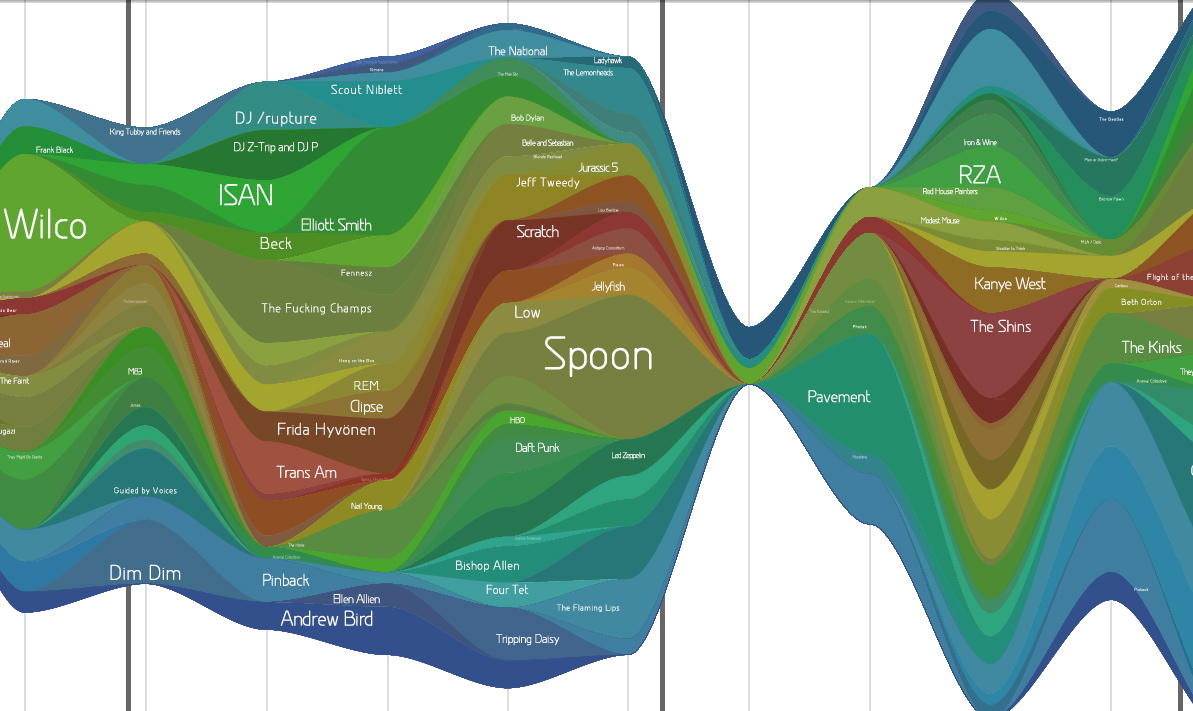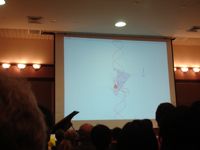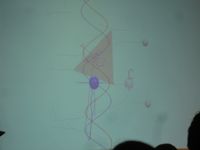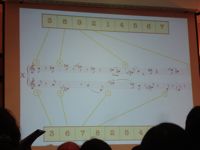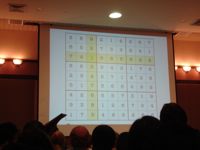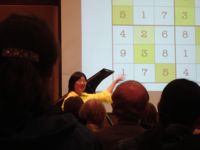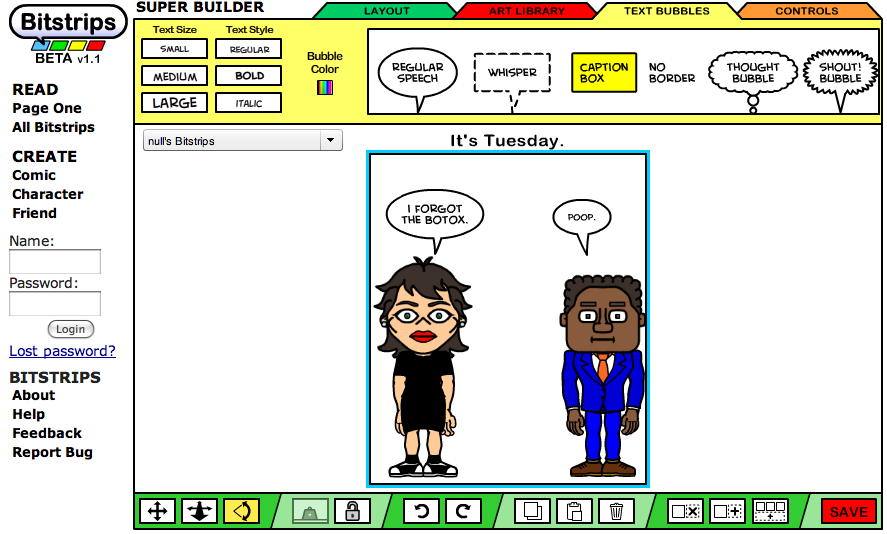LastGraph
Make graphs of your last.fm listening history at LastGraph.
Get the detailed PDF from which the above was captured (it’s so pretty).
Wordle
Wordle is a fun tool for making what I will call “nice-looking tag clouds”. It’s like tag-tinted glasses for the written world.
Here are two I made today.
LaTeX – from the first few paragraphs of the Wikipedia entry on LaTeX
My del.icio.us tags – from my del.icio.us
These are super-customizable but I can’t let myself play with it that long. (That’s what she said.)
I am very busy finishing my thesis; the plan now is to finish and move out of Cambridge at the end of July. I will come back to blogging, hopefully daily again, at that point. I miss it quite a bit. So stay tuned…
The Mathematics in Music
I went to a very interesting performance today: “The Mathematics in Music: a concert-conversation with Elaine Chew”, in Killian Hall at MIT. Elaine is visiting Harvard for the year from USC, where she is a professor. She has an amazingly broad background that is super-pleasing… having studied math, computer science, music performance, and operations research.
Elaine performed four piano pieces, three of which were composed just for her, that use playful tricks in math as compositional inspiration. Some of these tricks included:
- Composing with a meter determined by the numbers in a row (or column) of a completed Sudoku puzzle. This piece had a different time signature for every measure… 3/8, 1/8, 7/8, 9/8, and so on, accompanied by an entirely different sequence for the other hand. I was very impressed that anyone could play a piece like that. Listening in the audience, you want desperately to tap your foot to ground yourself in some kind of beat, but it’s impossible.
- A bi-tonal piece: right hand and left play in different keys. Chew likened this to patting your head and rubbing your belly at the same time.
- Genetic programming: The composer applies the idea of genetic mutations and substitutions on a familiar theme at the note and phrase level, which results in some jarring effects.
Elaine and her colleague, Alexandre Francois, developed a way of visualizing tonality called MuSA.RT, which accompanied her during two of the pieces. MuSA.RT shows (as a real-time accompaniment to MIDI-enabled piano) the changing notes and key of the piece along a spiral that is kind of like a 3-D version of the Tonnetz. More on the model in Elaine’s paper (PDF).
John is leaving
This is not a “best thing”, but it feels momentous… John Maeda is leaving the Media Lab. He’s off to RISD at the end of the month.
John gives his last lecture this Friday, 3:30pm, in Bartos. His students made some awesome posters to commemorate his time here.

Make your own comics
I am very happy about Web 2.0 today. It sort of hit a trampoline when I saw kottke post the most elaborate Line Rider track ever. People are crazy! Crazy awesome.
Then I saw Bitstrips on boingboing: “BitStrips is a fast, easy, sharing-friendly comic creation site — you make ‘characters’ using a Wii-style menu, pose them and fill in dialog, layout your strips and monkey with the backgrounds, borrowing material from any of the thousands of strips that have been made to date.” Yarg, this is the perfect distraction from my thesis.
Haeckel illustrations
Ack! I almost wet myself just now, after realizing that tons of Ernst Haeckel illustrations are available in high-res, in the public domain, on Wikipedia. I am downloading them now. I’m going to cycle through them for my desktop background. And someday I am going to make them into wallpaper prints. (You know, when I get some walls.) Seriously, can you imagine??
This one would look awesome in the guest bathroom…

If you’d like a zip file of all the Haeckel images I downloaded, you can get it here. It’s 187 MB, 121 images.
Where the yin yang symbol comes from
 Wow, this page has a description of where the yin yang symbol comes from. It claims that the symbol is actually a graph of the length of the shortest shadow observed each day throughout one year. It’s a simple spiral.
Wow, this page has a description of where the yin yang symbol comes from. It claims that the symbol is actually a graph of the length of the shortest shadow observed each day throughout one year. It’s a simple spiral.
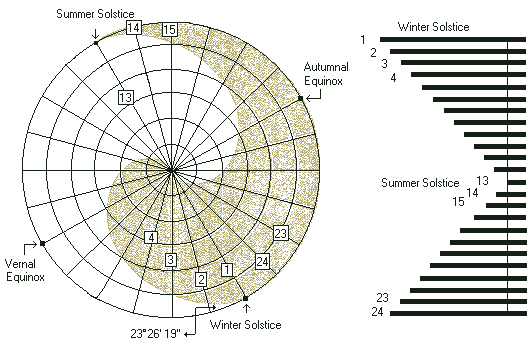
(Apologies for linking to pages with pop-up ad windows!)
About learning
Today I had this reinforced: If you’re struggling to learn something, try something even harder.
Now, I’ll definitely admit that this doesn’t always work, but it should be considered more often. It reminds me of how Chemistry in college was really hard for me from the start, but I stuck with it, and even though the stuff I was currently learning never got any easier, the stuff we’d already learned did.
Here’s how it came up today: I’m taking a “Pre-Masters” swimming class twice a week now, and I am learning flip-turns. When we started two weeks ago, I couldn’t believe how hard they were. Missing the wall, shooting off sideways, gasping for breath. Just two days ago I was practicing them and still spluttering. Last time, my teacher starts telling me I need to start doing backstroke flip-turns… and I resisted. (My backstroke is horrible.) “I can’t even swim straight! And I don’t know where the wall is!”
But today she made me try a backstroke flip-turn, and, well, it wasn’t great, but it wasn’t as bad as I’d thought. And after adding that extra level of complication, the freestyle flip-turns seem like a cinch! “Hey, I can totally see the wall coming, this is awesome.”
So that goes to show me that a little insecurity looking forwards can also mean a little confidence looking back. It’s a lesson I’ve been reminded of many times, in many places; and even if it’s just flip-turns in the pool, it’s a good lesson to learn.
Whistled language
Some cultures use a whistled language to communicate. This means that speech is emulated in whistling, which can cover much larger distances.
From Wikipedia:
Whistled languages are normally found in locations with difficult mountainous terrain, slow or difficult communication, low population density and/or scattered settlements, and other isolating features such as shepherding and cultivation of hillsides (Busnel and Classe 1976: 27 – 28). The main advantage of whistling speech is that it allows the speaker to cover much larger distances (typically 1 – 2 km but up to 5 km) than ordinary speech, without the strain (and lesser range) of shouting.
…
As two people approach each other, one may even switch from whistled to spoken speech in mid-sentence.
This page has a nice example of a whistled conversation in Sochiapam Chinantec, a tonal language spoken in part of southern Mexico. The whistled version of the language is only spoken by men. (The conversation is interrupted by a modern telephone ring, which amused me greatly.)
Another example of whistled language, ‘Silbo Gomero’: CNN.com — “Nearly extinct whistling language revived”
Thanks to Chris for sharing such excitement about the Pirahã people and their language.
Nice cookies

If you want a tasty project, try making these Chocolate Chocolate-Chip Cookies With Mocha Cream Filling. We made them for the game night last Friday. They are: scrumptious.
